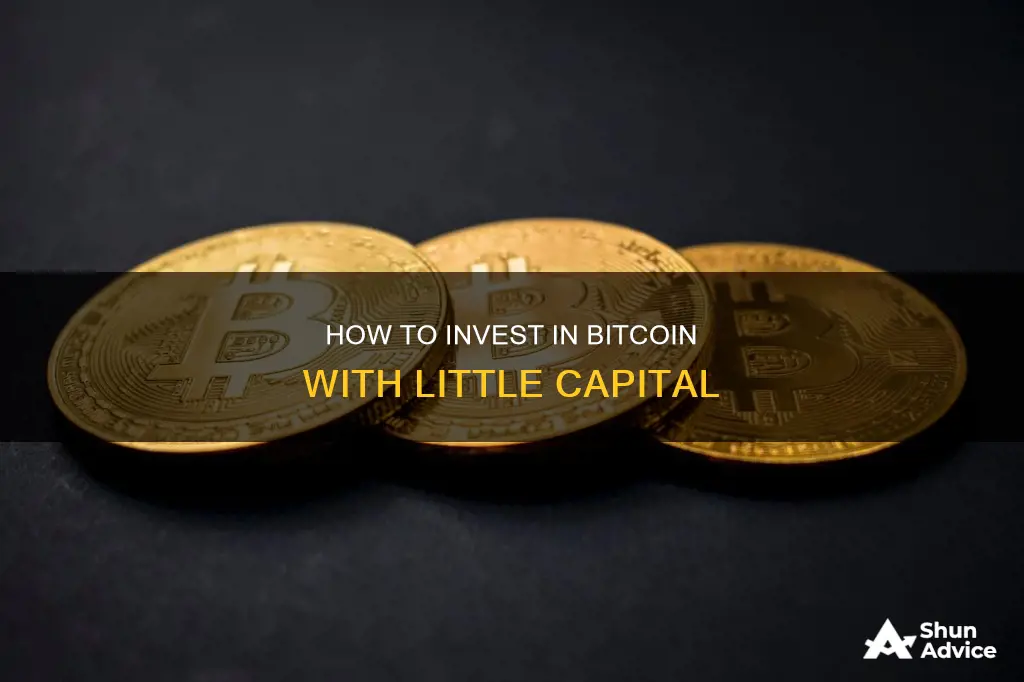
Bitcoin is a cryptocurrency, a virtual currency that can be used as a source of purchasing power. It is one of the most volatile assets, with large price swings. It is also highly susceptible to market manipulation. Due to its volatility, it is important to understand the risks involved before investing in Bitcoin. While it is possible to buy less than one Bitcoin, it is recommended that you only invest an amount you are willing to lose. There are several ways to invest in Bitcoin, including through cryptocurrency exchanges, traditional brokers, money transfer apps, Bitcoin ATMs, and Bitcoin ETFs.
| Characteristics | Values |
|---|---|
| Minimum Investment | As little as $30 |
| Volatility | High |
| Risk | High |
| Accessibility | High |
| Investment Options | Direct, ETPs, ETFs, Stocks |
| Investment Horizon | Long-term |
| Investment Amount | No more than 1% to 5% of net worth |
What You'll Learn

Buying Bitcoin with little money
Bitcoin is a cryptocurrency, a virtual currency that can be used as a source of purchasing power. It is decentralised, meaning it is not issued, backed, or regulated by a central authority like a government. It is overseen by an online, decentralised network of users and guarded by encryption through blockchain technology.
Bitcoin is the dominant force in the market for cryptocurrencies, but there are thousands of others. It is possible to buy less than a whole bitcoin, and even to buy fractional shares. This is because 1 BTC can cost tens of thousands of dollars, so you can get started with as little as $30 worth of Bitcoin.
There are several ways to buy Bitcoin with little money:
- Cryptocurrency exchanges: You can purchase bitcoin from cryptocurrency exchanges such as Gemini, Kraken, Coinbase, and Crypto.com. Many offer dozens of cryptocurrency choices, while others simply have Bitcoin and a few alternatives. They carry a variety of different fees and consumer protections, so do your research before choosing.
- Traditional stockbrokers: There are a few traditional brokers that give customers a way to buy and sell Bitcoin, including Robinhood, Webull, TradeStation, and Fidelity.
- Bitcoin exchange-traded funds (ETFs): On 10 January 2024, the Securities and Exchange Commission opened the door for spot Bitcoin ETFs, which track the price of Bitcoin and trade over major exchanges. This was a long-awaited approval, and one that is expected to make it even easier for traditional investors to gain access to Bitcoin.
- Peer-to-peer money transfer apps: Cash transfer services like PayPal, Venmo, or Cash App allow their users to purchase Bitcoin using the apps. You can purchase, store, send and sell Bitcoin directly through the apps, which is convenient if you're used to those interfaces.
- Bitcoin wallets: You can store Bitcoin in two kinds of digital wallets: a hot wallet or a cold wallet. A hot wallet is stored by a trusted exchange or provider in the cloud and accessed through an app or computer browser on the internet. A cold wallet is a small, encrypted portable device that allows you to download and carry your Bitcoin. Cold wallets can cost less than $100 and are considered much more secure than hot wallets.
It is important to remember that buying cryptocurrency involves inherent risks, just like any investment. It is a volatile asset, and there are many unknowns about how this new form of currency will develop in the future. It is best to talk to a financial advisor familiar with cryptocurrency to learn if it's suitable for your financial circumstances and portfolio.
Small Steps to Investing in Bitcoin
You may want to see also

Bitcoin wallets
Yes, you can buy less than a whole bitcoin. This is true for almost all cryptocurrencies, but is particularly true for cryptocurrencies like Bitcoin, where 1 BTC costs tens of thousands of dollars.
Hot Wallets are on a device that is connected to the internet. They are often free to use, offering add-on services such as trading or staking in exchange for fees. Hot wallets make it relatively easy to carry out transactions using crypto, but they may be more vulnerable to hackers. Examples of hot wallets include:
- Crypto.com DeFi Wallet
- Zengo Wallet
- Guarda
- Exodus
- Coinbase Wallet
- Trust Wallet
- MetaMask
Cold Wallets are on a device that is disconnected from the internet. They tend to cost money, as you have to buy a piece of hardware that is set up to store your crypto. Cold wallets may be harder for other users to reach, but if you lose the device, recovery could be very difficult. Examples of cold wallets include:
- Ledger
- Trezor
When choosing a wallet, it's important to consider how many types of digital assets are supported, how easy it is to move crypto offline, and whether there are resources for in-app staking or rewards programs.
BlackRock's Bitcoin ETF: A Guide to Investing
You may want to see also

Crypto exchange platforms
There are two main types of crypto exchanges: centralized and decentralized. Centralized exchanges are managed by a single corporate authority and are more beginner-friendly, while decentralized exchanges distribute responsibility for facilitating and verifying crypto trades among those willing to join a network and certify transactions. Decentralized exchanges can be more challenging to use and may not support direct currency conversion.
When choosing a crypto exchange platform, it is important to consider factors such as security, fees, the range of cryptocurrencies offered, customer service, and the platform's reputation and regulatory compliance. Some popular crypto exchange platforms include:
- Kraken: One of the oldest crypto exchanges, offering a solid range of coins and competitive trading fees. It provides advanced features like margin trading and a suite of educational resources.
- Gemini: Available in all 50 US states, Gemini offers a simple, intuitive user interface and a wealth of educational materials. It also has strong security measures and supports over 70 digital currencies.
- Coinbase: A beginner-friendly platform with an easy-to-use interface and a large number of supported cryptocurrencies. Coinbase offers robust security measures and advanced trading options, but its fees can be relatively high.
- Crypto.com: Supports more than 350 cryptocurrencies and provides a range of crypto products, including a native token and a crypto Visa card. The mobile app offers a wide range of features, making it a good choice for those seeking a mobile crypto trading experience.
- Bisq: A decentralized exchange that allows users to buy and sell Bitcoin and other cryptocurrencies securely and privately. Bisq does not require user registration or identity verification and supports various payment methods. However, it may not be suitable for beginners due to its complex peer-to-peer trading process.
- Binance: One of the largest crypto exchanges by trading volume, offering a wide variety of cryptocurrencies and derivatives trading options.
- Huobi Global: A top exchange for trading derivatives, offering a percentage-based fee structure with competitive taker fees.
Bitcoin or Dash: Which Crypto is Worth Your Investment?
You may want to see also

Traditional stockbrokers
Step 1: Choosing a Platform
Firstly, you will need to choose a platform that offers crypto trading. Traditional stockbrokers such as Robinhood, Webull, TradeStation, and Fidelity are some of the options available. When choosing a platform, it is important to consider factors such as minimum investment requirements, security, and liquidity. Robinhood, for example, charges no fees for Bitcoin trades, but it is important to research each platform's unique features.
Step 2: Weighing Storage Options
Since crypto is a digital-only asset, you will need a secure location to store your Bitcoin. You have two main options: a hot wallet or a cold wallet. Hot wallets are online wallets provided by crypto exchanges or software providers, while cold wallets are offline devices that store your crypto passkeys. Hot wallets are more susceptible to hacking, so selecting an insured and well-regulated provider is crucial. On the other hand, cold wallets protect against hacking but are easier to lose, so it is important to weigh the pros and cons of each option.
Step 3: Deciding How Much to Invest
Bitcoin can be purchased in fractional shares, so your initial investment can be as low as you are comfortable with. It is important to assess your risk tolerance and long-term investment strategy when deciding how much Bitcoin to buy. Some experts recommend limiting your investment to under 5% of your net worth, and never investing more than you can afford to lose.
Step 4: Managing Your Investments
You can choose to day-trade Bitcoin or adopt a long-term investment strategy. Day trading involves attempting to profit from short-term price movements, while a long-term strategy may involve buying and holding Bitcoin for potential long-term gains. It is important to consider your financial goals and risk tolerance when deciding on an investment strategy.
Step 5: Understanding the Risks and Benefits
Before investing in Bitcoin, it is crucial to understand the risks and benefits associated with this volatile asset. Bitcoin carries a substantial risk of loss and is not suitable for risk-averse investors due to its extreme volatility. On the other hand, Bitcoin offers unique diversification benefits and the potential for significant profits. It is important to carefully evaluate your investment goals and conduct thorough research before investing in Bitcoin.
Blockchain Bitcoin Investment: A Beginner's Guide to Getting Started
You may want to see also

Bitcoin exchange-traded funds
ETFs are traded on stock exchanges, providing investors with diversified exposure to various asset classes and the flexibility to buy or sell shares throughout the trading day at market prices. Instead of holding a bunch of different stocks, an investor can simply own shares of one ETF that is invested in those companies.
A futures contract is a standardised contract where two parties agree to exchange a specific quantity of a standardised asset on a specific day for a particular price. Bitcoin futures contracts are traded on the Chicago Mercantile Exchange (CME). So, a Bitcoin futures ETF is an exchange-traded fund that holds Bitcoin futures contracts and sells shares of the fund to investors. These shares are bought and sold on a mainstream exchange.
The first official Bitcoin-linked ETF was the ProShares Bitcoin Strategy ETF (BITO), which mainly uses futures contracts. It was approved by the SEC in October 2021 and is listed on the New York Stock Exchange.
The goals of Bitcoin futures ETFs are to allow more people to invest in Bitcoin without the necessary expenses and hassles of buying them directly. They eliminate the need for security procedures and excessive funds while providing a familiar investment type.
However, it is important to note that investing in these cryptocurrency ETFs is risky due to the large price swings of Bitcoin.
The Ultimate Guide to Investing in Bitcoin via Cash App
You may want to see also
Frequently asked questions
Yes, you can buy less than a whole Bitcoin. You can invest in Bitcoin with as little as $30.
You can buy Bitcoin through a broker or a cryptocurrency exchange. Examples of cryptocurrency exchanges include Gemini, Kraken, Coinbase and Crypto.com.
Bitcoin can be a risky investment due to its volatile nature. It's important to conduct thorough research and understand the risks before investing.
It's recommended that you only invest an amount you can afford to lose. Some experts advise investing no more than 1-5% of your net worth in cryptocurrencies.
You can store your Bitcoin in a hot wallet or a cold wallet. A hot wallet is connected to the internet, making transactions faster, while a cold wallet is a physical device that is more secure but can be costly if you lose the associated keycode.







